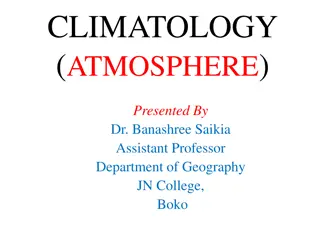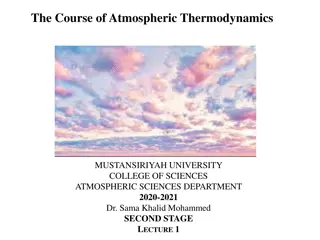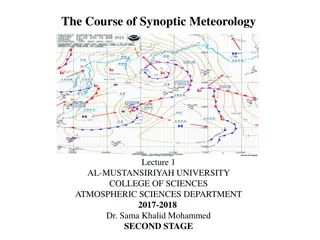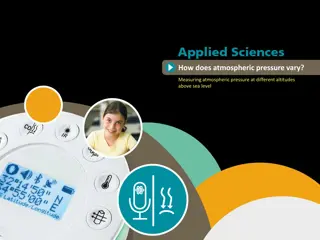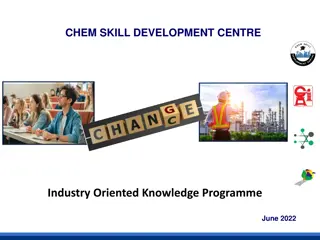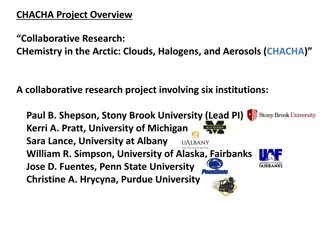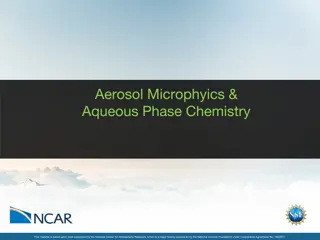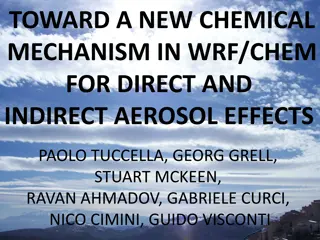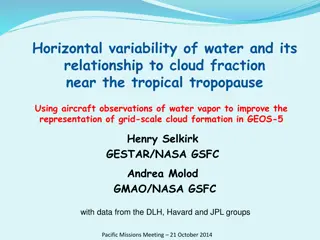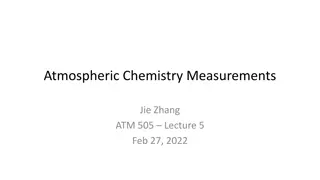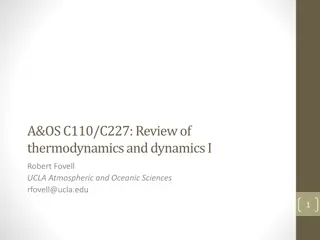GEOS-Chem Atmospheric Chemistry Model Overview
GEOS-Chem, developed by Daniel J. Jacob at Harvard University, is a global model of atmospheric composition used to understand human and natural influences on the environment. The model addresses various atmospheric chemistry issues on different scales, from local to global, and is regularly updated with new versions. GEOS-Chem incorporates input meteorological data from NASA, solves 3-D chemical continuity equations, and covers topics such as tropospheric and stratospheric chemistry, aerosol microphysics, and carbon gases. It also serves as an online chemical module for Earth System Models, allowing for dynamic simulations of chemical transport.
Uploaded on Oct 04, 2024 | 3 Views
Download Presentation

Please find below an Image/Link to download the presentation.
The content on the website is provided AS IS for your information and personal use only. It may not be sold, licensed, or shared on other websites without obtaining consent from the author.If you encounter any issues during the download, it is possible that the publisher has removed the file from their server.
You are allowed to download the files provided on this website for personal or commercial use, subject to the condition that they are used lawfully. All files are the property of their respective owners.
The content on the website is provided AS IS for your information and personal use only. It may not be sold, licensed, or shared on other websites without obtaining consent from the author.
E N D
Presentation Transcript
GEOS-Chem model overview Daniel J. Jacob, Harvard University GEOS-Chem Community Mission: to advance understanding of human and natural influences on the environment through a comprehensive, state-of-the-science, readily accessible global model of atmospheric composition GEOS-Chem user groups IGC8 meeting (Harvard, May 2017)
Atmospheric chemistry: many problems, many scales plume1 Ozone layer Visibility We need models to Disasters LA-smog-2 Understand processes Confront our understanding to observations Interpret observations to generate new knowledge Make projections Link atmospheric chemistry to other Earth system processes Urban smog Climate forcing Regional smog Biogeochemical cycles Plume dispersion Acid rain GLOBAL > 1000 km LOCAL < 100 km REGIONAL 100-1000 km
GEOS-Chem atmospheric chemistry model Input meteorological data NASA GEOS fields, 1980-present 0.25o 0.3125o or 0.5ox0.625o, 72 vertical levels GEOS-Chem solves 3-D chemical continuity equations on global or nested Eulerian grid Modules emissions transport chemistry aerosols deposition Applications Model adjoint Tropospheric and stratospheric chemistry, aerosol microphysics, carbon gases, mercury including biogeochemical coupling, POPs, isotopes New version releases every year: v11-2 (May 2018) to include updated SOA, isoprene chemistry, tropospheric halogen (Cl-Br-I) chemistry, methane, emissions Grid-independent, ESMF-compatible architecture for coupling to Earth System models
GEOS-Chem as on-line chemical module for Earth system models (ESMs) any 3-D grid specified at run time ESMF ESMF ESMF ESMF O Mixing Convection Emissions (HEMCO): dC/dt = E Advection Chemistry (FlexChem): dC/dt = P L - D Off-line GEOS-Chem CTM GEOS-Chem chemical module
GEOS-Chem as on-line chemical module for Earth system models (ESMs) any 3-D grid specified at run time ESMF ESMF ESMF O Emissions (HEMCO): dC/dt = E Chemistry (FlexChem): dC/dt = P L - D Dynamics, chemical transport Earth System Model with GEOS-Chem chemistry GEOS-Chem chemical module
GEOS-Chem as on-line chemical module for Earth system models (ESMs) any 3-D grid specified at run time ESMF ESMF ESMF ESMF ESMF O Mixing Convection Emissions (HEMCO): dC/dt = E Chemistry (FlexChem): dC/dt = P L - D Advection Dynamics, chemical transport Earth System Model with GEOS-Chem chemistry Off-line GEOS-Chem CTM GEOS-Chem chemical module CTM and ESM use exactly the same GEOS-Chem code ESM GEOS-Chem module always stays referenced to latest version GEOS-Chem CTM users contribute model advances Advances are incorporated into GEOS-Chem Keller et al.. [2014]; Long et al. [2015]
Full-year tropospheric chemistry simulation at c720 (~12 km) resolution using on-line GEOS-Chem in GEOS ESM August 1, 2013 0Z Hu et al. [2018]
GEOS-Chem high performance (GCHP): Massively parallel capability with cubed-sphere advection uses distributed-memory MPI parallelization enabled by ESMF 1-month simulation of troposphere-stratospheric chemistry at c180 (~50 km) resolution requires only 1 day of wall time with 540 cores Ozone at 4 km altitude, July 2016 Wall time Aerosol optical depth (AOD), July 2016 Number of cores Eastham et al. [2018]
Running GEOS-Chem on the cloud GEOS-Chem is now fully operational on the AWS cloud; GCHP is on the way Many advantages for access, reproducibility, sharing of model versions and data Jiawei Zhuang, Harvard
GEOS-Chem Steering Committee Model scientist: Jacob (Harvard) co-scientist: Martin (Dalhousie) Adjoint scientist: Henze (U. Colorado) Nested model scientists: Wang (Tsinghua/UH), Zhang (PKU) Engineer: Yantosca (Harvard) Aerosols WG: Heald (MIT), Alexander (UW), Pierce (CSU), Yu (SUNYA) Chemistry WG: Henderson (EPA), Evans (York), Mao (U. Alaska), Hu (U. Montana) Emissions and Deposition WG: Lin (PKU), Fischer (CSU), Millet (U. Minnesota) Chemistry-Ecosystems-Climate WG: Liao (NIUST), Tai (CUHK), Murray (U. Rochester), Geddes (Boston U) Carbon WG: Jones (U. Toronto), Bowman (JPL) Adjoint and Data Assimilation WG: Wang (U. Iowa), Henze (U. Colorado) Transport WG: Liu (NIA), Molod (NASA) Hg and POPs WG: Holmes (FSU), Fisher (U. Wollongong) GCHP WG: Martin (Dalhousie), Eastham (MIT) GMAO Liaison: Keller (NASA) At large: Kasibhatla (Duke).) GEOS-Chem development is driven by its user community Working Groups set priorities contribute developments, report bugs support implement priorities Model Support Team (Harvard, Dalhousie, U. Colorado) benchmark updates Model version updates Emphasize grass-roots development, fast innovation, traceability, user support
GEOS-Chem v11-02 to be released this week V11-02a: chemical updates including PAN chemistry (US EPA, U. York, CSU) V11-02b: GCHP capability (GEOS-Chem Support Team) V11-02c: isoprene chemistry and SOA updates (U. Wollongong, U. Birmingham, Caltech, CSU, Harvard) V11-02d: comprehensive halogen chemistry (U. York, U. Copenhagen, MIT, Harvard) V11-02e: stratospheric chemistry updates, full NetCDF diagnostics (MIT, FSU) V11-02f: many new emission inventories, new methane simulation, new Hg chemistry (Dalhousie, Harvard, UW, U. Birmingham )
Building GEOS-Chem v11-3: expected release in May 2019 Search GEOS-Chem development priorities to get the list of potential updates Weigh in through your WG chairs on the items you want! Some major items: Grid-independent natural emissions Enabling 12-km resolution in both GCHP and GC-Classic Rediagnosed convection to improve transport in coarse-resolution simulations Updated tropospheric isoprene and halogen chemistry Mesospheric chemistry Many emission updates including MEIC Enable nested simulations over any custom domains CESM coupling off-line and on-line Harmonized biosphere-atmosphere exchange, coupling to CLM
Chemistry challenges How do we get to a unified mechanistic mechanism for SOA? o Simple seems to do best, but are we satisfied with that? Full tropospheric-stratospheric Cl-Br-I chemistry o Major tropospheric ozone sink at mid-latitudes from seasalt aerosol how do we fix? Updating isoprene chemistry o New reduced Caltech mechanism has 150 species Aromatic chemistry and terpene chemistry are still sketchy Speeding up the model o Mechanism reduction? o Machine learning? o Crowd sourcing through the cloud?
Progress in emissions HEMCO has made updating emission inventories much easier but beware of black box need to check what comes out Grid-independent natural emissions will be major advance Harmonized biosphere-atmosphere exchange, coupling to CLM Continual challenge to update emissions to latest years o Community participation is key Need to facilitate update of specialty simulations Hg chemistry moving to KPP Need to maintain aerosol microphysics simulations
Push to higher resolution AQ applications look for higher resolution, also evidence that coarse model resolutions produce transport errors Two approaches: Off-line simulations matched to highest GEOS resolution (now 12 km) o Advantages: - Ease of use - Cost - Reproducibility - Inverse applications o Disadvantages: - Loss of information in temporal archiving of met data - Management of large archive - Cannot go finer than GEOS resolution On-line simulations with hi-res met model using GEOS-Chem chemical module o Advantages: - Specific on-line applications: chem-climate, data assimilation - Explore different meteorological simulations, high resolution o Disadvantages: see off-line advantages Some other considerations: As resolution increases, on-line becomes more desirable Many of our applications don t need very high resolution .so a model with both on-line and off-line capabilities makes sense Have the exact same GEOS-Chem chemical module in all applications
Off-line approaches: GC-Classic and GCHP GC-Classic is to be maintained indefinitely (or until it has outlived its usefulness) Ease of access and use Nested model capability can be extended to higher resolutions GCHP: a powerful tool for the future High-performance applications through MPI Better transport through FV3 on cubed sphere Challenge #1: difficulty of use o Solve with access through cloud? o Simplify the MAPL coupler? Challenge #2: Availability of cubed-sphere native archive o Prototype archive being tested: air mass fluxes and pressure Challenge #3: dealing with model nesting o Use stretched-grid approach?
On-line approach: GEOS-Chem chemical module Coupling to GEOS-5 and to BCC is already in place o But these models are not open access Coupling to WRF very exciting for AQ applications! o a much better, more transparent chemical module than current WRF-Chem Coupling to NCAR CESM development being led by Seb Eastham o Prototype version to be presented to NCAR next week o Strong buy-in from NCAR they want GEOS-Chem
Looking to the future: balancing community needs for innovation and stability GEOS-Chem Community Mission: to advance understanding of human and natural influences on the environment through a comprehensive, state-of-the-science, readily accessible global model of atmospheric composition GEOS-Chem is unique among atmchem models in its ease of use; allows atm chemists with low computing resources to contribute scientific innovation But they wouldn t use it if it didn t stay at the cutting edge of science meaning that we have to continuously innovate in both the science and the underlying software engineering But somebody s cutting edge of science is someone else s unnecessary update and users are stressed when the model keeps changing This is particularly the case for specialty simulations that get broken in model updates On the other hand, continued support for older versions would unduly stress the Support Team Best solution is for GEOS-Chem Steering Committee to provide guidance in striking a balance between innovation and stability
See you at IGC9! May 6-9 2019, Harvard University IGC8 meeting (Harvard, May 2017)




